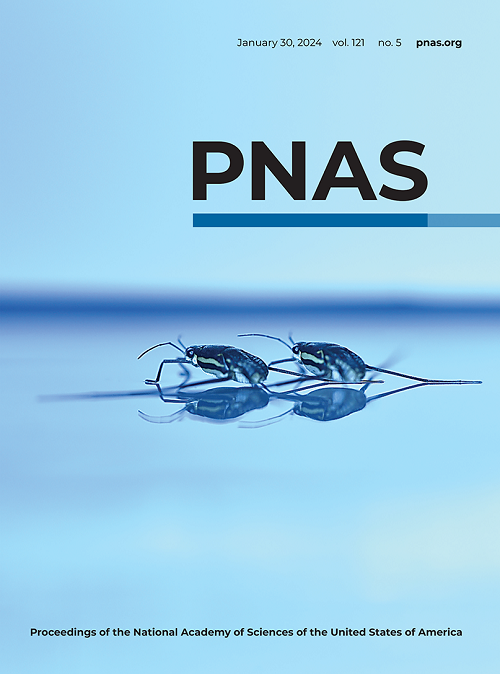Lenacapavir在稳定衣壳晶格的同时破坏HIV-1核心的完整性
IF 9.1
1区 综合性期刊
Q1 MULTIDISCIPLINARY SCIENCES
Proceedings of the National Academy of Sciences of the United States of America
Pub Date : 2025-04-01
DOI:10.1073/pnas.2420497122
引用次数: 0
摘要
来那卡韦(GS-6207;LEN)是一种强效的HIV-1噬菌体抑制剂,已被批准用于治疗耐多药感染。LEN能与六聚体中相邻噬菌体(CA)蛋白之间的疏水袋结合并稳定噬菌体晶格,但它对HIV-1噬菌体的作用还不完全清楚。在这里,我们用融合了CA的绿色荧光蛋白(GFP-CA)或流体相GFP含量标记物(cmGFP)标记HIV-1噬菌体,以评估LEN对HIV-1噬菌体的影响。用 GFP-CA 标记的 HIV-1 核心可以用抗 GFP 抗体进行免疫染色,而用 cmGFP 标记的 HIV-1 核心则不行,而且对与噬菌体结合的宿主限制因子 MX2 的敏感性也较低,这表明 GFP-CA 与噬菌体晶格结合在一起,是噬菌体晶格稳定性的标记,而 cmGFP 则是核心完整性的指标。对分离的 HIV-1 核心进行 LEN 处理会导致 cmGFP 信号的剂量依赖性损失,而 GFP-CA 信号得以保留,这表明 LEN 会破坏核心的完整性,但会稳定噬菌体晶格。相反,噬菌体抑制剂 PF-3450074 (PF74) 则会导致核心完整性和噬菌体晶格的丧失。对经 LEN 或 PF74 处理的病毒核进行电子显微镜观察发现,病毒帽的窄端经常断裂,并出现其他形态变化。我们的研究结果表明,LEN处理不会阻止核包膜对接,但会抑制核芯的核输入,无论核芯是否失去完整性。与此相反,PF74 处理通过抑制病毒核的核包膜对接来阻止核导入,突出了它们不同的核导入抑制机制。本文章由计算机程序翻译,如有差异,请以英文原文为准。
Lenacapavir disrupts HIV-1 core integrity while stabilizing the capsid lattice
Lenacapavir (GS-6207; LEN) is a potent HIV-1 capsid inhibitor approved for treating multidrug-resistant infection. LEN binds to a hydrophobic pocket between neighboring capsid (CA) proteins in hexamers and stabilizes the capsid lattice, but its effect on HIV-1 capsids is not fully understood. Here, we labeled HIV-1 capsids with green fluorescent protein fused to CA (GFP-CA) or a fluid-phase GFP content marker (cmGFP) to assess LEN’s impact on HIV-1 capsids. HIV-1 cores labeled with GFP-CA, but not cmGFP, could be immunostained with an anti-GFP antibody and were less sensitive to the capsid-binding host restriction factor MX2, demonstrating that GFP-CA is incorporated into the capsid lattice and is a marker for capsid lattice stability, whereas cmGFP is an indicator of core integrity. LEN treatment of isolated HIV-1 cores resulted in a dose-dependent loss of cmGFP signal while preserving the GFP-CA signal, indicating that LEN disrupts core integrity but stabilizes the capsid lattice. In contrast, capsid inhibitor PF-3450074 (PF74) induced loss of core integrity and the capsid lattice. Electron microscopy of LEN- or PF74-treated viral cores revealed frequent breakage at the narrow end of the capsid and other morphological changes. Our results suggest that LEN treatment does not prevent nuclear envelope docking but inhibits nuclear import of cores with or without loss of core integrity. In contrast, PF74 treatment blocks nuclear import by inhibiting the nuclear envelope docking of viral cores, highlighting their different mechanisms of nuclear import inhibition.
求助全文
通过发布文献求助,成功后即可免费获取论文全文。
去求助
来源期刊
CiteScore
19.00
自引率
0.90%
发文量
3575
审稿时长
2.5 months
期刊介绍:
The Proceedings of the National Academy of Sciences (PNAS), a peer-reviewed journal of the National Academy of Sciences (NAS), serves as an authoritative source for high-impact, original research across the biological, physical, and social sciences. With a global scope, the journal welcomes submissions from researchers worldwide, making it an inclusive platform for advancing scientific knowledge.

 求助内容:
求助内容: 应助结果提醒方式:
应助结果提醒方式:


